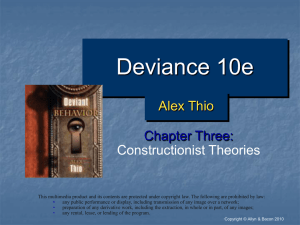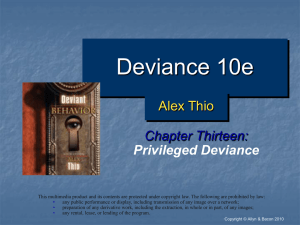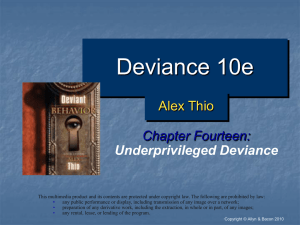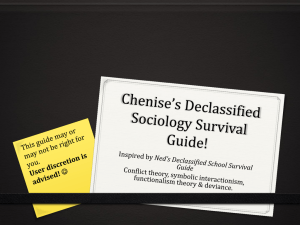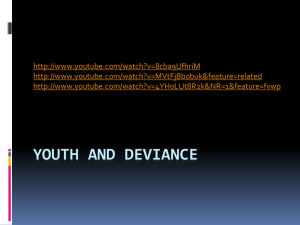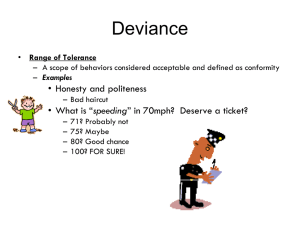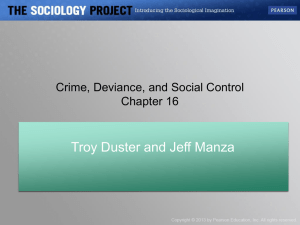Chapter 1
advertisement
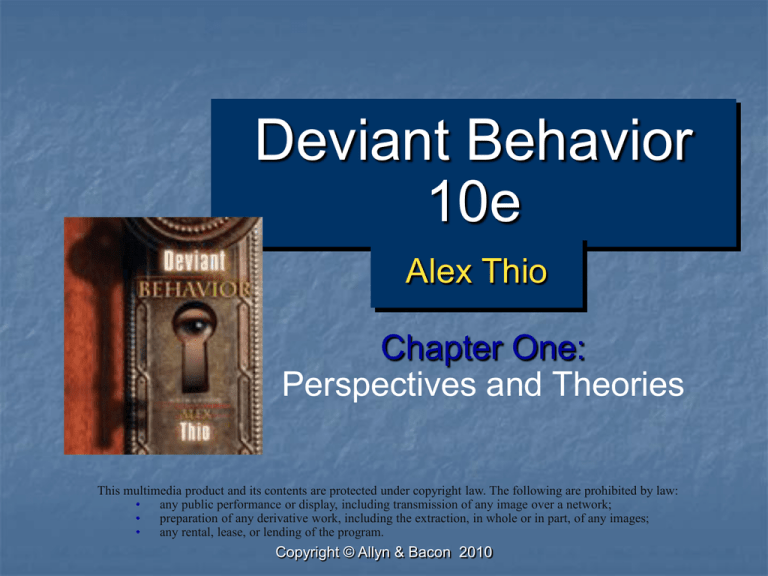
Deviant Behavior 10e Alex Thio Chapter One: Perspectives and Theories This multimedia product and its contents are protected under copyright law. The following are prohibited by law: • any public performance or display, including transmission of any image over a network; • preparation of any derivative work, including the extraction, in whole or in part, of any images; • any rental, lease, or lending of the program. Copyright © Allyn & Bacon 2010 Conflicting Definitions Sociologists have a proposed variety of definitions for deviant behavior Violation of any social rule Must provoke disapproval, anger or indignation Physical or mental disability Positive deviance – geniuses, saints, creative artists and glamorous Copyright © Allyn & Bacon 2010 celebrities Conflicting Definitions – cont. Some say deviance is real in and of itself Others point out that some are falsely accused or misdiagnosed as deviant Deviance is less a function of act and more a function of being labeled as deviant (labeling theory) Copyright © Allyn & Bacon 2010 Conflicting Definitions – cont. Others point to role of power in defining deviance, detection of deviance and successful being labeled deviant Powerful people label others, particularly the poor and powerless, as deviant Those in power make social rules Copyright © Allyn & Bacon 2010 Conflicting Definitions – cont. Positivistic perspective: associated with physical sciences; deviance is intrinsically (absolutely) real Constructionist perspective: from arts and philosophy; deviance is imputed (created and assigned meaning) by society to some behavior or set of behaviors and qualities Copyright © Allyn & Bacon 2010 The Positivist Perspective Assumes deviance is absolute or intrinsically real (absolutism), an objective fact, and determined behavior Weaknesses: Failure to discover bio or psych traits that distinguish criminals from non-criminals Does not recognize changing and relative nature of criminal statuses Copyright © Allyn & Bacon 2010 The Positivist Perspective – cont. Today, positivists recognize social factors as determining criminal status and changes in status across time, space and culture Emphasize objectivity of deviance Assume that deviance has intrinsic characteristics that hurt members of society Copyright © Allyn & Bacon 2010 The Positivist Perspective – cont. Deviance is observable object, has objective nature that can be studied. Positive sociologists used to believe they could study human behavior in same way as natural scientists. Today they see subjects as human beings with feelings But they still see deviance as objective and seek causes of deviant behavior. Copyright © Allyn & Bacon 2010 The Positivist Perspective – cont. Determined behavior is belief that deviance is caused by environment (social and physical) Humans have some free choice but are influenced by social environmental features such as broken homes and social class Copyright © Allyn & Bacon 2010 The Positivist Perspective – cont. Positivist Perspective in Sum: The Positivist perspective on deviance consists of three basic assumptions: Deviance is absolutely real (deviance has qualities to set it apart from the conventional) Deviance is an observable object (a deviant person or act of deviance can be observed and studied objectively) Deviance is determined (by forces beyond the individual) Copyright © Allyn & Bacon 2010 The Constructionist Perspective Emerged in 1960s to challenge positivistic perspective Assumes deviance is a label, a subjective experience and a voluntary act Copyright © Allyn & Bacon 2010 The Constructionist Perspective – cont. Deviance does not have intrinsic value, but rather comes from people’s minds Act is deviant only because people think it is Police and others have role in labeling process Acts can be labeled as deviant by one group and not by another Deviance is in the eye of the beholder Copyright © Allyn & Bacon 2010 The Constructionist Perspective – cont. Deviant people are feeling, thinking, and reflective subjects of worth and dignity It is crucial to understand how a deviant sees him/herself and society Avoids stats and surface appearance; takes subjective approach (seeks to understand lived experiences) Copyright © Allyn & Bacon 2010 The Constructionist Perspective – cont. Sees deviance as a voluntary act because humans have free will Seeks to analyze how social control agencies define some people as deviant and carry out sanctions against them Copyright © Allyn & Bacon 2010 An Integrated View Both positivist and constructionist perspectives are needed to define deviance Deviance is both real and a label and one cannot exist without the other The Positivist perspective is more relevant to serious deviance like murder Constructivist views are more pertinent to less serious deviance Copyright © Allyn & Bacon 2010 An Integrated View – cont. Deviance is defined as any behavior considered deviant by public consensus (which may range from maximum to minimum) Positivists study higher-consensus deviance Constructionists study lowerconsensus deviance Copyright © Allyn & Bacon 2010 Deviance and Crime Deviance differs from crime and criminology because: 1. 2. 3. 4. Crime always involves breaking a law but deviance may not Crime is a violation of a formal norm, while deviance is typically a violation of informal norms There is a far greater number and variety of deviant acts than crime Some crimes are not (considered) deviance due to their acceptance throughout society Copyright © Allyn & Bacon 2010


